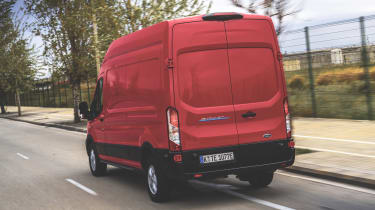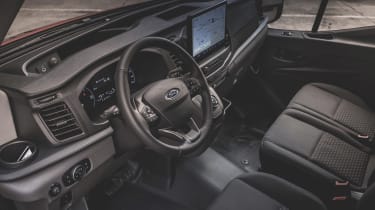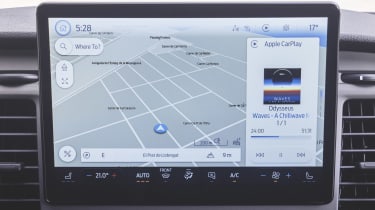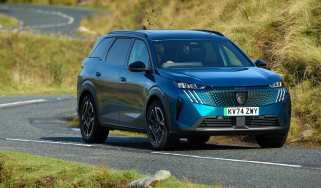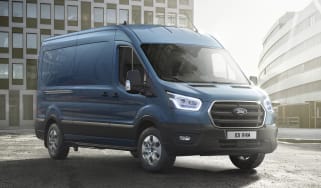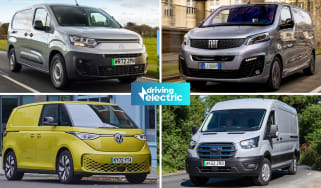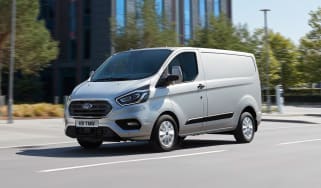Ford E-Transit review
The Ford E-Transit is a game-changer for the electric van market thanks to its a relatively long range, 115kW rapid charging and the variety of panel van sizes on offer
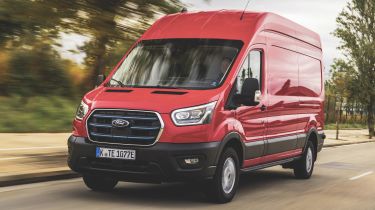
Pros
- Performance and refinement
- Several body size options
- Cheaper than its rivals
Cons
- One battery option
- Adaptive regenerative braking
- Electric parking brake
| Van type | Range | Wallbox charge time | Rapid charge time |
|---|---|---|---|
| Electric | 196 miles | 8hrs (0-100%, 11kW) | 34mins (15-80%, 115kW) |
The Ford E-Transit is the electric version of the Transit – easily the most famous van in the UK. The arrival of the E-Transit is a pretty big deal, not just for the van world, but for EVs in general, as it’s the first of five electric vans Ford plans to launch in coming years. It marks a big stride towards Ford’s all-electric future.
The E-Transit has a plenty of rivals to go up against, including the Fiat E-Ducato – winner of our 2022 Best Large Electric Van award – Citroen e-Relay, Peugeot e-Boxer, Vauxhall Movano-e, Renault Master E-TECH and Mercedes eSprinter. But, it has the potential to set the new standard for the electric van market, particularly with the launch of Ford Pro, the company’s new approach to van ownership – more on that later.
The E-Transit itself ditches the diesel model’s engine and transmission for a 68kWh battery incorporated into the van’s sturdy ladder frame chassis and an electric motor sourced from the Mustang Mach-E SUV that drives the rear wheels. As standard, the motor produces 181bhp, or you upgrade to a far more potent 266bhp output – roughly 20bhp more than a Volkswagen Golf GTE pumps out. Both motors produce 430Nm of torque.
The E-Transit is available in two height and three length variations, offering between 9.5 and 15.1 cubic metres of cargo space, while the maximum payload weight for the regular panel-van version can reach 1,758kg. In total, there's a range of 25 configurations available, made up of panel-van, double-cab and chassis-cab bodies, the various length and height options and a range of gross vehicle mass (GVM) options up to 4.25 tonnes.
The E-Transit has a claimed maximum range of 196 miles from a fully charged battery, and charges at up to 115kW, which is more than twice as fast as the E-Ducato can be topped up. As a result, replenishing the 68kWh battery from 15-80% charge can be done in as little as 34 minutes from a powerful enough rapid charging-point.
If you have a three-phase, 11kW wallbox at work, the E-Transit can be charged to full in eight hours. The charging port can be found in the van’s nose, below the E-Transit's large Ford badge, in the middle of the grille which also features chrome blue trim accents to help distinguish it from the regular diesel models.
All-in-all, by adding a battery drivetrain to the Transit, Ford has created the best electric van we’ve driven to date. Even the less powerful version we tried had enough punch to make the E-Transit feel quick off the line, the powertrain making this large van seem extremely quiet and refined. It’s plenty of power to cope with big payloads, too; our van had a maximum capacity of almost one tonne. Cabin comfort is good, but as with a lot of vans in this segment, the ride is even better when there’s some payload on board.
Like most electric cars, the E-Transit has several settings for the regenerative braking. You also get a choice of regular drive mode or press the ‘L’ button in the centre of the rotary drive selector to add more resistance, similar to the ‘B’ modes you’ll find in some electric cars. We believe most drivers will be happy sticking with one of the two standard levels on offer, however, the E-Transit does offer a kind of adaptive energy recuperation as well.
A brief press on the brake pedal gives you a more intermediate level of recuperation between the standard modes, while two taps increases the strength closer to ‘L’. Once you come to a halt or accelerate, the level resets. Frankly, it’s not the most intuitive system to use and can be quite fiddly, especially compared to EVs that use a set of paddles on the steering wheel to adjust regen on demand.
The only other gripe we had with the E-Transit was its electric parking brake. While only a minor thing, we’d have liked it to activate automatically when selecting Park, rather than the driver having to trigger it manually.
But overall, the tall driving position, big mirrors and plenty of cabin storage boost the E-Transit’s everyday appeal, plus it features a 12-inch touchscreen set-up as standard. Other tech on offer includes adaptive cruise control, climate control and a host of electronic driver aids. The E-Transit is also available with what Ford calls a ‘ProPower Onboard’ panel, which delivers up to 2.3kW from standard plug sockets in the cab and load area, to power tools, lights, laptops and conversions such as refrigeration units.
Then there’s the new Ford Pro service, which adds what we think could be another level of user-friendliness to the E-Transit. Pro is short for Productivity in this case, and Ford describes it as an “end-to-end” service that helps businesses manage their fleets. It’s available for firms small or large, whether they’re running electric, diesel or even non-Ford vehicles, and provides support for charging infrastructure and vehicle maintenance.
The E-Transit is offered in two trim levels: Leader and Trend, with a starting price of £47,700 excluding VAT and the government’s plug-in van grant. The base model comes with keyless start, 12-inch central touchscreen, metal bulkhead, Ford’s Quickclear windscreen and heated seats. Upgrading to Trend spec adds front and rear parking sensors, lane departure warning and cruise control among other features.
That’s still a jump in price of nearly £15,000 from an entry-level diesel model, but the E-Transit offers plenty to put it at the top of the electric van class. That includes a relatively long range, class-leading rapid charging capability, a comprehensive selection of panel van sizes and conversion options, and the fact it's significantly cheaper than the Fiat E-Ducato equipped with a 79kWh battery.
